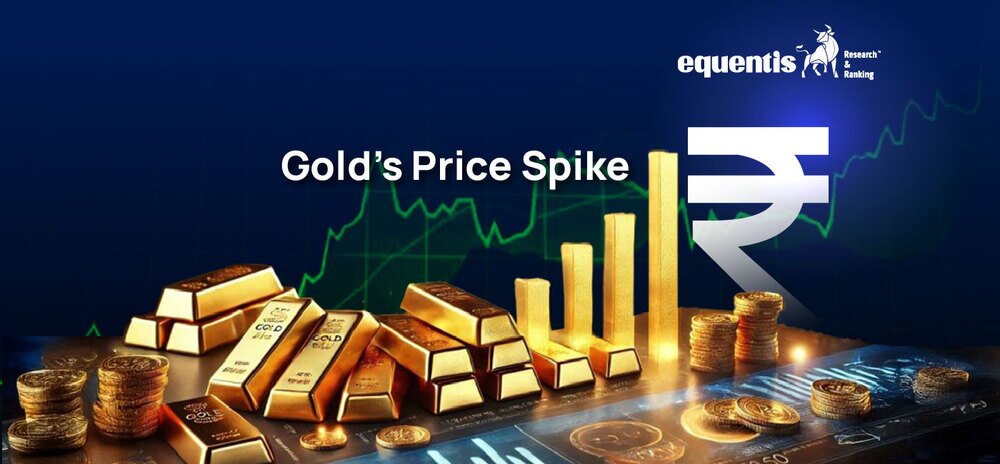The Immediate Market Response
In a dramatic turn of events, global markets tumbled as U.S. President Donald Trump announced sweeping tariffs on multiple foreign goods, triggering fears of escalating trade wars and economic stagnation. The S&P 500 and Nasdaq 100 futures fell sharply, with the Dow Jones Industrial Average plunging over 1,000 points in a single trading session. Major U.S. tech giants such as Apple, Amazon, and Nvidia saw a significant dip in their stock values due to their exposure to international supply chains, which are now at risk of higher costs and trade restrictions (Business Insider).
Conversely, gold surged to an all-time high, reaching $3,167.57 per ounce—a 19% increase year-to-date. Investors flocked to the safe-haven asset amid heightened uncertainty, underscoring the metal’s historical role as a shield against financial volatility (Reuters).
Why Is Gold Surging?
Gold’s resurgence as a favored asset isn’t just a knee-jerk reaction to trade tariffs—it’s an economic signal. Historically, gold has been a refuge for investors during financial distress, and the current climate is no exception. Several factors are driving the recent surge:
- Stagflation Fears: Analysts warn that slowing economic growth and rising inflation—reminiscent of the 1970s stagflation—could erode actual returns on stocks and bonds, making gold an attractive alternative (MarketWatch).
- Weakening Dollar: The dollar index slipped following Trump’s tariff announcements, making gold cheaper for foreign investors and increasing demand. Historically, gold has an inverse relationship with the U.S. dollar, benefiting when the greenback weakens.
- Central Bank Accumulation: Several central banks, including China, India, and Russia, have significantly increased their gold reserves to reduce reliance on the U.S. dollar. In 2023 alone, central banks purchased over 1,100 metric tons of gold—the highest annual demand in history, according to the World Gold Council (World Gold Council).
- Inflation Hedge: As tariffs increase the cost of imported goods, they create inflationary pressures. Higher prices reduce the purchasing power of fiat currencies, making gold a more attractive store of value.
- Flight from Equities: With stock markets in turmoil and bond yields offering little respite due to central banks’ cautious monetary policies, gold presents a relatively stable alternative.
- Currency Weakness: A significant depreciation in major currencies, particularly the Chinese yuan and the euro, has prompted investors to shift toward gold to preserve capital.
- Geopolitical Uncertainty: Global trade conflicts, wars, and political instability in key economies have made gold an even more compelling asset.
World Gold Council’s Perspective
The World Gold Council (WGC), a leading authority on gold markets, has emphasized the growing demand for gold among central banks and investors. WGC CEO David Tait recently stated that “every indicator suggests that gold prices will continue to rise, given the increasing demand from institutional and retail investors.”
The Council highlights three significant trends supporting the gold rally:
- De-Dollarization Efforts: Many countries are moving away from U.S. dollar reserves due to geopolitical tensions and economic sanctions, favoring gold as a more stable asset.
- ETFs and Institutional Buying: Gold-backed exchange-traded funds (ETFs) have seen a resurgence in inflows, particularly in European and Asian markets.
- Retail Demand in Emerging Markets: India and China, the world’s largest gold consumers, continue to drive demand due to cultural, economic, and investment reasons.
David Tait, CEO of the World Gold Council, recently stated, “Gold’s resilience and appeal as a hedge against economic shocks make it a crucial part of any long-term investment strategy.”
India’s Gold Holdings and Its Economic Impact
India’s relationship with gold is deeply entrenched in cultural and economic traditions. Indian households collectively hold approximately 25,000 tonnes of gold, making it one of the largest private reserves in the world. But beyond jewelry and cultural significance, gold plays a vital economic role:
- Wealth Preservation: In rural India, where banking infrastructure remains limited, gold is a financial security net.
- Investment Alternative: Indian investors often turn to gold during economic instability, driving demand for gold bars and sovereign gold bonds.
- Trade Deficit Concerns: India imports nearly all of its gold, which can strain the country’s trade balance when global prices surge. The government has attempted to curb excessive imports through higher import duties and schemes like gold monetization programs.
- Cultural Affinity: Gold is deeply ingrained in Indian traditions, particularly in weddings and festivals, making it a preferred asset regardless of economic conditions.
- Economic Security: With limited access to formal financial instruments, many rural and semi-urban households view gold as their primary source of wealth preservation.
The Global Economic Outlook
The current financial landscape suggests continued volatility, with trade wars, inflation fears, and geopolitical risks dictating market movements. As a result, gold is expected to maintain its upward trajectory, with analysts predicting prices could reach $3,500 per ounce by the end of the year if economic uncertainties persist.
Conclusion
President Trump’s tariff announcements have once again underscored the fragility of global financial markets. While equities stumble under economic uncertainty, gold has reaffirmed its status as a resilient safe-haven asset. With central banks and investors doubling down on gold, its role in wealth preservation is stronger than ever. Understanding these dynamics will be crucial for investors looking to safeguard their portfolios as the world navigates turbulent economic waters.
Related Posts
Disclaimer Note: The securities quoted, if any, are for illustration only and are not recommendatory. This article is for education purposes only and shall not be considered as a recommendation or investment advice by Equentis – Research & Ranking. We will not be liable for any losses that may occur. Investments in the securities market are subject to market risks. Read all the related documents carefully before investing. Registration granted by SEBI, membership of BASL & the certification from NISM in no way guarantee the performance of the intermediary or provide any assurance of returns to investors.
How useful was this post?
Click on a star to rate it!
Average rating 0 / 5. Vote count: 0
No votes so far! Be the first to rate this post.
waitfor delay '0:0:5'--
I’m Archana R. Chettiar, an experienced content creator with
an affinity for writing on personal finance and other financial content. I
love to write on equity investing, retirement, managing money, and more.
 Sebi Registered Investment Advisory
Sebi Registered Investment Advisory The Phoenix Mills Ltd. (PDF)
The Phoenix Mills Ltd. (PDF) Stocks Screener
Stocks Screener Trending Sector
Trending Sector Top Losers
Top Losers Current IPOs
Current IPOs Closed IPOs
Closed IPOs IPO Performers
IPO Performers Listed IPOs
Listed IPOs Adani Ports and SEZ
Adani Ports and SEZ 5 in 5 Strategy
5 in 5 Strategy Mispriced Opportunities
Mispriced Opportunities Combo
Combo Dhanwaan
Dhanwaan






















